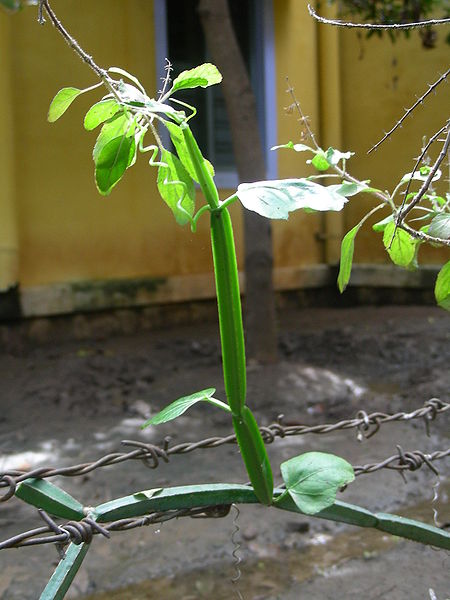Cissus quadrangularis for bone strength
Cissus quadrangularis
Cissus quadrangularis is an ancient medicinal plant native to the hotter parts of Ceylon and India. It was prescribed in the ancient Ayurvedic texts as a general tonic and analgesic, with specific bone fracture healing properties. Modern research has shed light on Cissus’ ability to speed bone healing by showing it acts as a glucocorticoid antagonist (1,2). Since anabolic/androgenic compounds are well known to act as antagonists to the glucocorticoid receptor as well as promote bone growth and fracture healing, it has been postulated that Cissus possesses anabolic and/or androgenic properties (1,3). In addition to speeding the remodeling process of the healing bone, Cissus also leads to a much faster increase in bone tensile strength. In clinical trials Cissus has led to a fracture healing time on the order of 55 to 33 percent of that of controls. That cissus exerts antiglucocorticoid properties is suggested by a number of studies where bones were weakend by treatment with cortisol, and upon administration of Cissus extract the cortisol induced weakening was halted, and the healing process begun.
While the increased rate of bone healing may be of great significance to persons suffering from chronic diseases like osteoporosis (4), the antiglucocorticoid properties of Cissus are likely of much more interest to the average bodybuilder or athlete, since endogenous glucocorticoids, particularly cortisol, are not only catabolic to bone, but catabolize muscle tissue as well. Numerous studies over the years have suggested that glucorticoids, including the body’s endogenous hormone cortisol activate pathways that degrade not only bone, but skeletal muscle tissue as well. A recently published report documented exactly how glucocorticoids (including cortisol) induce muscle breakdown: They activate the so-called ubiquitin-proteasome pathway of proteolysis (5). This pathway of tissue breakdown is important for removing damaged and non-functional proteins. However, when it is overactive during periods of elevated cortisol (e.g disease states, stress, and overtraining) excess amounts of normal tissue are broken down as well. By exerting an anabolic, antiglucorticoid effect cissus helps preserve muscle tissue during times of physical and emotional stress.
Although the bulk of the research on Cissus centers around bone healing, the possibility exists that Cissus may act to improve bone healing it may improve the healing rate of connective tissue in general, including tendons. If this is the case it would be of great benefit to bodybuilders and athletes.
Besides the above-mentioned properties of Cissus, the plant is also rich in the vitamins/antioxidants vitamin C and beta-carotene. As analyzed, Cissus quadrangularis contained ascorbic acid 479 mg, and carotene 267 units per 100g of freshly prepared paste in addition to calcium oxalate (6).
The typical recommended daily dosage of Cissus extract is between 100 and 500 mg, depending on the concentration of the extract and the severity of symptoms. For the powder of the dried plant, the Ayurvedic texts recommend a dosage of 3 to 6 grams to accelerate fracture healing. Safety studies in rats showed no toxic effects at dosages as high as 2000 mg/kg of body weight. So not only is Cissus efficacious, it is also quite safe, in either the dried powder form or the commercially available extract.
Cissus also possess analgesic properties on a mg per mg basis comparable to aspirin or anti-inflammatory drugs like ibuprofen. Cissus quadrangularis constitutes one of the ingredients of an Ayurvedic preparation, `Laksha Gogglu’, which has been proved to be highly effective in relieving pain, reduction of swelling and promoting the process of healing of the simple fractures as well as in curing the allied disorders associated with fractures (7). The mechanism through which Cissus exerts its analgesic and anti-inflammatory properties has not been well characterized. It may act centrally, but the anti-inflammatory features suggest that it acts by preventing the conversion of arachidonic acid to inflammatory prostaglandins.
1) Chopra SS, Patel MR, Awadhiya RP. Studies of Cissus quadrangularis in experimental fracture repair : a histopathological study Indian J Med Res. 1976 Sep;64(9):1365-8
2) Chopra SS, Patel MR, Gupta LP, Datta IC. Studies on Cissus quadrangularis in experimental fracture repair: effect on chemical parameters in blood Indian J Med Res. 1975 Jun;63(6):824-8.
3) PRASAD GC, UDUPA KN. EFFECT OF CISSUS QUADRANGULARIS ON THE HEALING OF CORTISONE TREATED FRACTURES. Indian J Med Res. 1963 Jul;51:667-76.
4) Shirwaikar A, Khan S, Malini S. Antiosteoporotic effect of ethanol extract of Cissus quadrangularis Linn. on ovariectomized rat. J Ethnopharmacol. 2003 Dec;89(2-3):245-50.
5) Combaret L, Taillandier D, Dardevet D, Bechet D, Ralliere C, Claustre A, Grizard J, Attaix D Glucocorticoids regulate mRNA levels for subunits of the 19 S regulatory complex of the 26 S proteasome in fast-twitch skeletal muscles. Biochem J. 2004 Feb 15;378(Pt 1):239-46.
6) Chidambara Murthy KN, Vanitha A, Mahadeva Swamy M, Ravishankar GA. Antioxidant and antimicrobial activity of Cissus quadrangularis L. J Med Food. 2003 Summer;6(2):99-105.
7) Panda, J Res Ayurv Siddha, 1990, 11, 7
